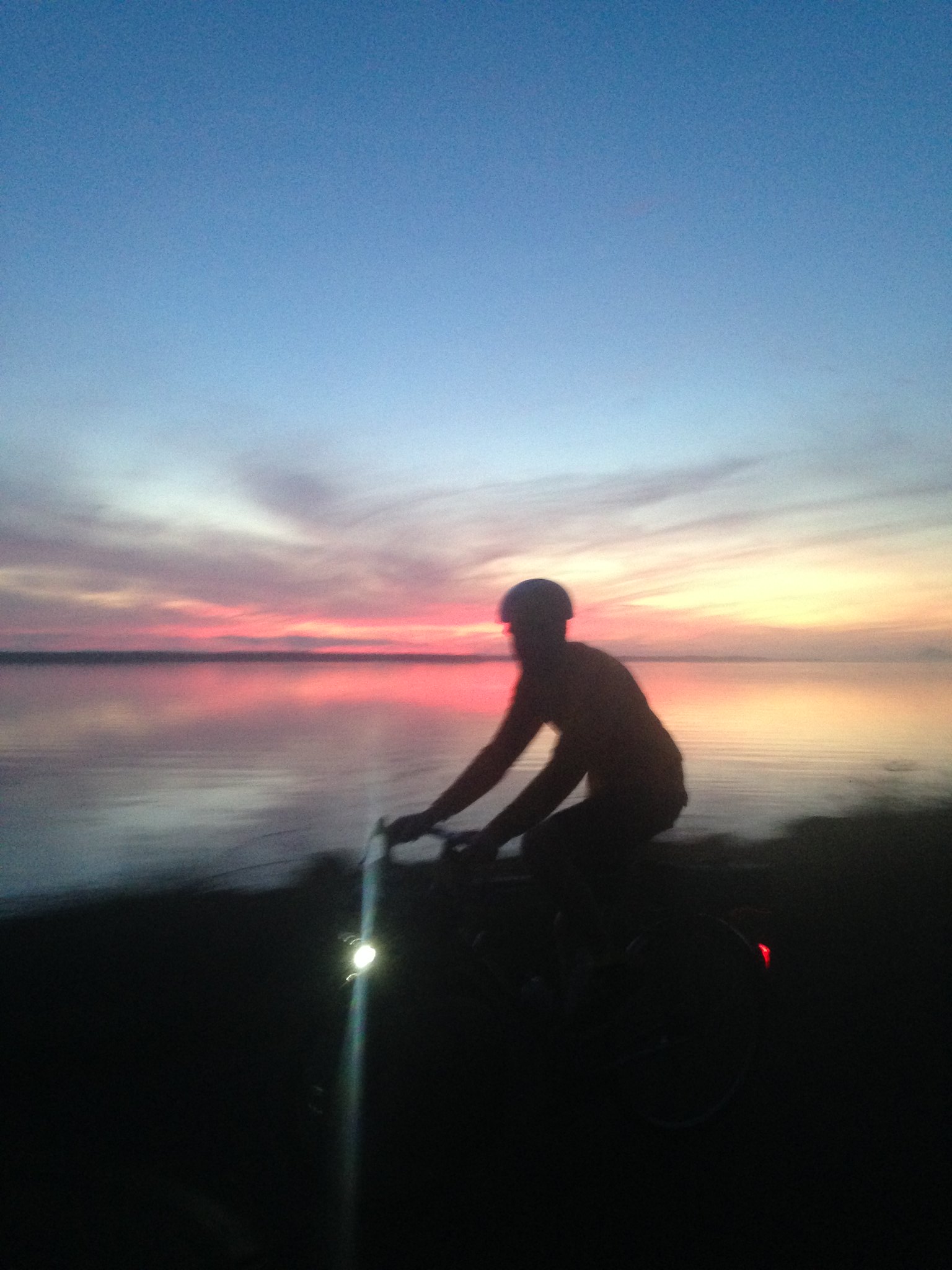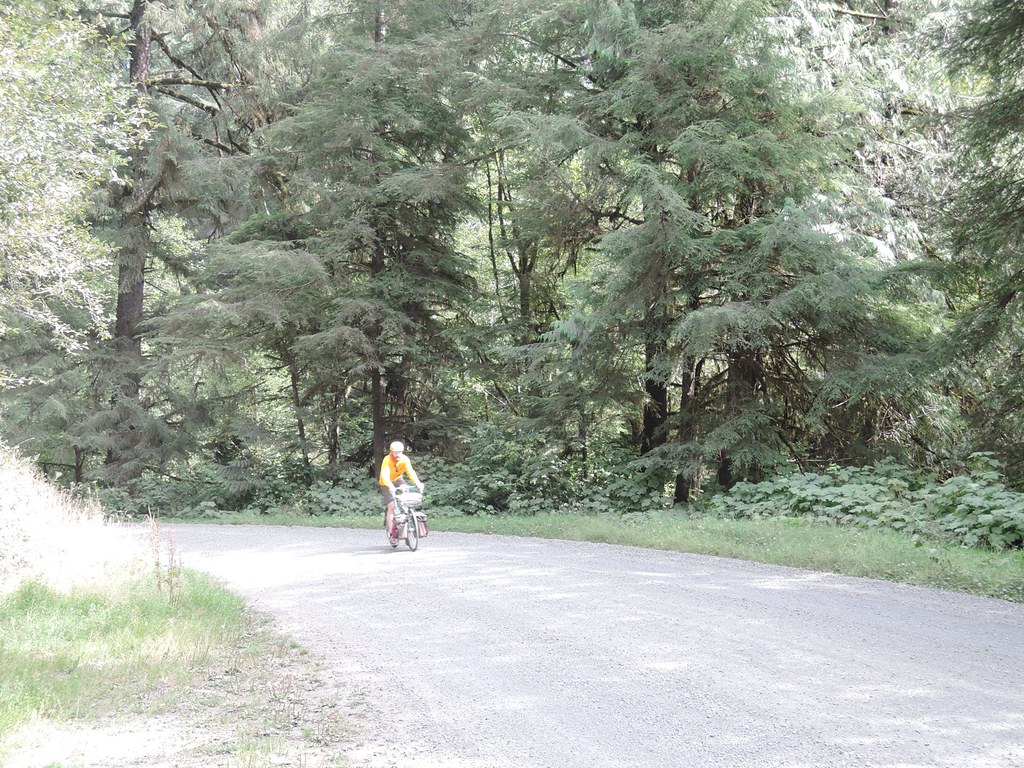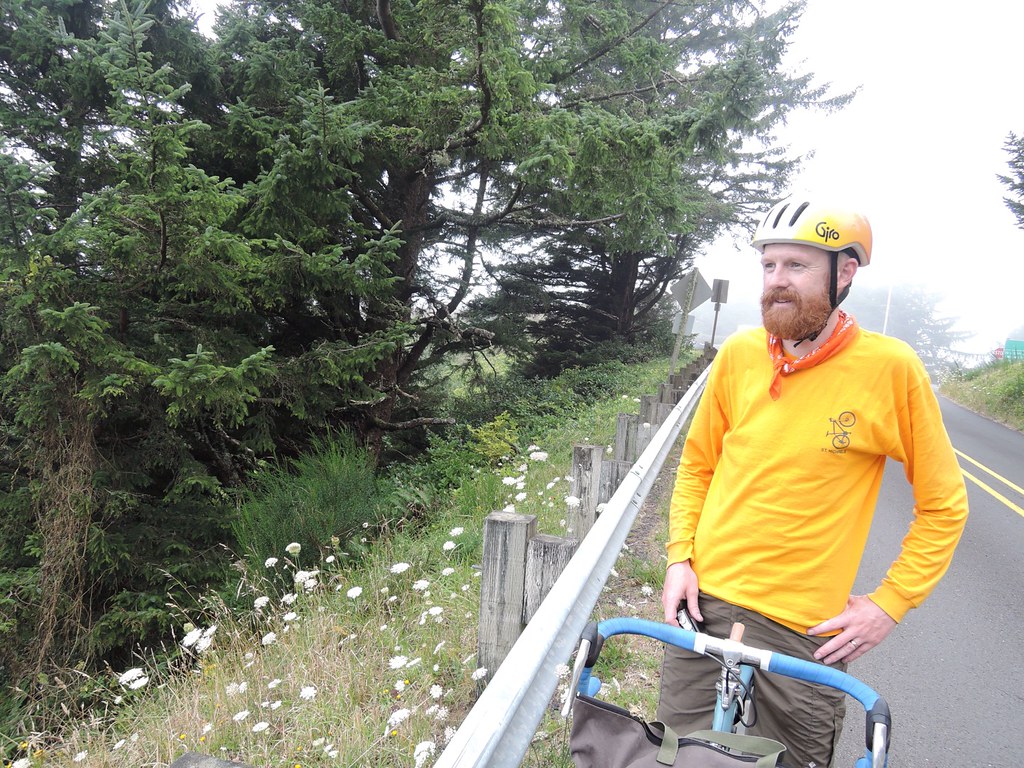Stories and Lessons from PDX to the Coast 2016
Too many words down there, just photos and more photos, please. This year's route.
-----------------------
Pal Oliver and I have done a summer ride from Portland to Otter Rock for several years running. It's always a great time, and we use it to try out different bike and ride strategies and to explore new alternatives to the typical coast routes. It's about 130 miles from the end of the MAX light rail in Hillsboro, with about 8,000 feet of climbing. Challenging enough but never brutal. We'd done it as a slow-rolling camping tour with 30 pound loads, a "spirited" day ride with 10 pound loads, and with a "transport stage" leaving work and riding out of the city at night with 15 pound loads to camp in the coast range the first night. Ollie's been pretty consistent with most of his weight up front (Kogswell P/R, Elephant NFE), while I've been all over the place with saddlebags, baskets, and small front or rear panniers (Riv Canti-Rom).
This year, schedules and an odd heat wave led us to a new option. We took the public Wave bus ($15) from Portland to Tillamook the first evening after work, saving us some hot suburban miles and dropping us off at the start of the gorgeous Three Capes loop. It also cut the mileage enough that we could explore a new gravel road that would bypass Lincoln City, the least best part of the route.
The bus worked well, and even though the A/C couldn't keep up on the 98F afternoon, we were happy to be rolling through the burbs under someone else's power. We'd decided to go light and simple this year, so our camping loads didn't include cooking gear. We stocked up on food and victory beers at Safeway and high tailed it out of TIllamook, where the temp was a pleasant 72 degrees. A few miles in, Ollie's rear Switchback Hill flatted, as he noted likely from PDX glass, but we were pretty quickly back on our way. Even the headwind was refreshing as we edged around the inland side of Cape Mears in soft evening light. The road over the top is closed due to slides, but we'd heard bikes could get through, so we soon turned up the climb and had the road to ourselves.
As we pedaled up and descended down Cape Mears, every peek-a-boo view of the Pacific had us slamming the brakes to take in the progressing sunset. An hour or more later, and we were rounding Netarts Bay into darkness, stopping one last time as the last light lit the clouds a brilliant red. We finished the short and sweet first day's pedal around 10:00 at Cape Lookout State Park, many of the last miles just us in the glow of our dynamo lights.
Photo: oliverbsmith
I set up my bivy sack and Ollie pitched his UL tent in one of the incredible hiker/biker sites at CLSP, and we ate our sandwiches and other store-bought provisions before taking our victory beers down to the beach to meteor watch. We fell asleep under tall trees with the ocean a stone's throw away, not even waking up to the sounds of a raccoon, cleverly pilfering three energy bars from Ollie's Swift rando bag. No damage done, and we had a good laugh envisioning our nighttime visitor hanging from the handlebars and figuring out the hook and loop pocket closure.
In the morning we packed up and rolled out around 8:30. The day started with the second climb, this time up Cape Lookout, and in a reversal of my last climb here, we ascended out of the fog and into the sun. We peeked off the top, and then enjoyed the long, sweeping descent into the dunes along Sandlake Rd. I was definitely a little envious of Oliver's fat tires on the descent. I didn't have as much margin for error with my 32mm tires on some of the heaves and rough pavement but managed okay.
We rolled past our usual stop at the one and only Sandlake Grocery and got a nod from the owner, who pretty much seems to live on the shady porch, and why not? Soon the ocean was in full view on our right, and after a couple of small climbs traversing Cape Kiwanda, I was fueling up on a beautifully greasy sausage egg croissant at Stimulus Cafe in Pacific City.
It's tough to avoid the next stretch of Hwy 101 to the lovely General Store in Neskowin, but, coffee and food-fueled, it passed by quickly enough. From there, we rode up familiar Slab Creek Rd, a highly-recommended detour around Cascade Head, despite the always challenging for me climb. I had a variation of H & O in my head as I pushed up the switchbacks--"She's a leg eater." Then it's the quiet, full-speed descent into Otis. Usually, a few corners are challenging and a good test of the bike and load. This year, a headwind scrubbed enough speed that I don't think I touched the brakes, but the scenery was still lovely.
After the slow climb and pleasant descent through old growth forest, the Otis Cafe is a bit of a shock, with traffic backed up down Hwy 18 all the way into Lincoln City, no shade in sight, and crowds of the road-weary beach-bound. None of that makes the milkshakes and ice cream taste any worse, though, and we downed our frozen rations with gusto on the front porch while we studied a map of the next stretch.
Photo: oliverbsmith
We'd plotted a route on new roads that would keep us out of the hot madness of weekend Lincoln City. The cost was a paltry 8 extra miles and a thousand feet of climbing. I thought I was prepared for the climb, but the loose, washboard gravel and grades topping out at 17 percent found me pushing my bike to the summit, helmet strapped to the bars and sweat pouring off my head. Ollie crested shortly after, in the saddle as expected from a seasoned randonneur. Any doubts about our choice were quickly put to rest on the descent, with gravel smooth enough to let us roll almost as freely as beautiful Schooner Creek on our left.
Back to the highway, choked with other escapees from the Willamette Valley, and we were soon tucked into the drops in full get there mode. We relaxed a bit and took in the views as we made the final ascent of our 70-mile, 4-climb day on the coast. Soon we were out of earshot of the highway, rolling through a light mist on Otter Crest Loop and nearing family and friends waiting at our destination.
Photo: oliverbsmith
Sane people who don't think about pneumatic trail and bottom bracket spindles while enjoying a bike ride might like to stop here, or go look at more photos (or even more photos)! This year's route.
-----------------------------
As I said, the trip is one of experimentation for me, and this year pretty much everything worked out beautifully. I carried my 20ish pound load entirely up front (with the exception of my lightweight but bulky sleeping pad) in Swift low-rider panniers and a basket- mounted Riv Shopsack. It was easily the best the bike has handled on these mini-tours. Great on descents, easy to keep in line up the steep bits, and zero shimmy even hands free. Despite it's relatively high-trail geometry, I'm sold on front-only loading for this bike. After more makeshift luggage setups, I was happy to carry the extra weight of the (canvas) Swift bags for the payoff of more organization. It was especially nice to have a pannier next to my bivvy to keep things dry and to swap layers during the night as needed. I continue to go with the cheap REI bivy even though I have a great UL tent. The bivy's just so simple to pack and deploy, and I love waking up under the summer stars. Come rainy season, I'd likely change my mind.
I was also breaking in new tires and an oddball modernized drivetrain on the trip. The 700x32 Panaracer GravelKing tires have a stupid name but a great ride. Despite costing me nearly double Paselas, they're my new reference tire. The GKs measure true to size (vs 1.5mm under for Paselas), weigh less and roll as well despite having a bead to bead protection belt, are dead quiet, and equal to Compass Stampede Pass tires in cornering feel. The GKs are supple but feel less delicate in hand, and I'm hoping the sidewalls prove more reliable for me than the Paselas' have. For me, they're equal to the (standard casing) Compass tires in performance, cost about twenty bucks less a piece, and should be a tougher.
The new drivetrain is bizarro. I swapped out my long-running 3 rings by 7-speed freewheel setup for a 2 x 10(!) cassette system. But, I kept my trusty Riv/Silver downtube friction shifters, which have been going strong on the original (!) cables for the last 30,000 miles. Going from a 14-28 freewheel to 11-34 cassette let me drop a ring up front without losing much low-end, and going to 10 speeds in back meant I didn't have to widen the gaps in my typical cruising range (50-75 gear inches). Dropping the ring also meant I could narrow my stance nearly a centimeter with a shorter bottom bracket, which is nicer for my mind and maybe for my knees. To my happy surprise, shifting 10 in back is totally fine with the old friction levers. In fact, shifts are cleaner than before, and it's really hard to be out of gear. I found I could sweep through several gears and only rarely have to trim the shift! Front shifting is a different story. I (possibly foolishly) bought a 10sp inner chainring, which has the teeth offset to the outside to narrow the gap to the big ring. That means it's incredibly hard to set an old, wide front derailer to make the shift without throwing the chain to the outside. I probably spent 3 hours on what's usually a 10-minute job to finesse it to good enough for the trip. I did throw the chain once cresting a climb, and upshifts were slow and clattery. I'll probably need to either go with a normal inner ring or else buy a narrower front derailer. All in all, though, a very successful trip, gear-wise!














